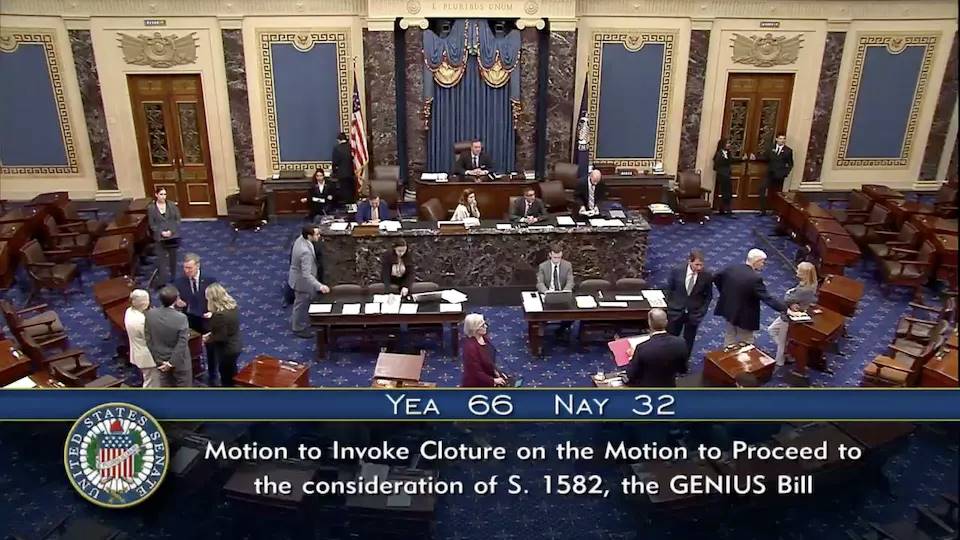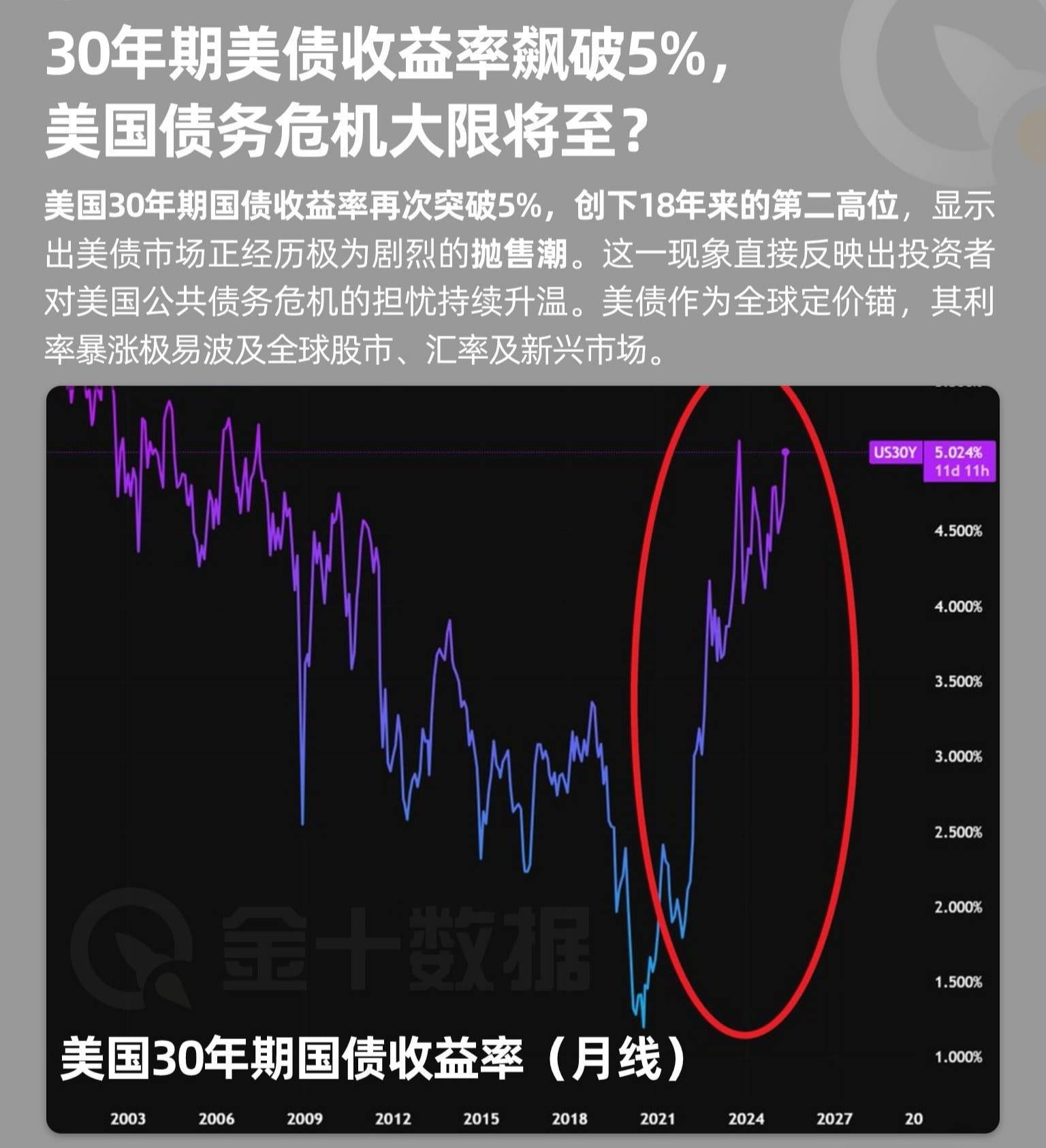Written by: Musol
Just recently, the US Senate passed the procedural motion for the GENIUS Bill with a vote of 66 to 32, meaning that stablecoins are entering the federal legislative "practical stage".

The US Senate advanced the debate on the GENIUS stablecoin bill with a vote of 66 to 32. Source: US Senate
This may be the first time our generation witnesses the "on-chain issuance of the US dollar" entering the legislative core; it may also be the first time we see whether the two swords of Damocles - stablecoins and US Treasury bonds - will fall to pierce people's final utopia. Behind this lies a profound restructuring of virtual currencies, the Web3 ecosystem, and the global payment landscape.
Pt.1. The Damocles Coin
Why is the stablecoin bill so important?
Stablecoins, as the name suggests, are cryptocurrencies pegged to assets like the US dollar with stable value. They serve as a "bridge" in the crypto market, widely used for trading, cross-border payments, and DeFi. In 2024, the global stablecoin market size has exceeded $200 billion, with US dollar stablecoins dominating. However, due to the lack of a clear regulatory framework, the stablecoin industry has been operating in a gray area, facing suspicions of money laundering, fraud, and systemic risks.

The core objectives of the GENIUS Bill are to establish clear regulatory rules for stablecoin issuers, including:
Issuance Requirements: Stablecoin issuers need to obtain federal or state licenses and meet strict capital and reserve requirements.
Anti-Money Laundering and Security: Strengthen AML and KYC measures to ensure stablecoins are not used for illegal activities.
Consumer Protection: Provide transparency and fund safety guarantees for users, preventing tragedies like the TerraUSD collapse in 2022.
Extraterritorial Jurisdiction: Limit foreign stablecoins from entering the US market, consolidating the US dollar's "hegemony" in the crypto world.
This vote is not only about regulating the crypto industry but is also seen as a strategic layout by the US in global financial technology competition. As US Treasury Secretary Besent said: "US dollar stablecoins will maintain the US dollar's status as an international reserve currency."
The Endgame of the Bill: Who Wins, Who Loses?
If the GENIUS Bill passes smoothly, several areas will undergo major changes:
Winners:
Stablecoin Issuers: Top issuers like Tether (USDT) and Circle (USDC) will obtain legal identities. Although compliance costs are high, market trust will significantly improve.
Crypto Exchanges: With clear regulations, platforms like Coinbase and Kraken are expected to attract more institutional funds, driving a surge in trading volume.
US Dollar Hegemony: The bill restricts foreign stablecoins from entering the US, further consolidating the global financial dominance of US dollar stablecoins. ECB President Lagarde once warned: "US dollar stablecoins may threaten the monetary sovereignty of the euro."
Investors: The standardization of stablecoins will reduce market risks, attract more traditional capital into the crypto field, and drive up asset prices.
Losers:
Non-Compliant Issuers: Small stablecoin projects unable to meet regulatory requirements may be eliminated.
Foreign Stablecoins: Stablecoins pegged to euros or the Chinese yuan will be restricted in the US market.
Decentralization Idealists: Strict KYC and AML requirements may undermine the anonymity of cryptocurrencies, sparking community controversy.
Any form of excessive currency issuance is immoral. Tether can issue USDT, but either you must completely remove it from real-world circulation after receiving one dollar, or your USDT cannot buy pizza and should only circulate within the crypto market, treating it like an online game.
No matter what, one dollar is one dollar and should never become two dollars. No matter how good the magic trick is, it remains a trick, a deceptive act. The higher you climb with such tricks, the harder you'll fall.
"We cannot let corruption blind us to the broader reality: blockchain technology is a done deal. If U.S. legislators do not guide it, other countries will step in—and not in a way that aligns with our interests or democratic values."
Pt.2. The Sword of Damocles

Source: Jin Shi Data
In 2025 and 2026, we know that the U.S. has massive national debt maturing, which is the Sword of Damocles hanging over the United States and Trump. Trump, at 80 years old, maintaining such high-intensity work in the recent 90 days is enough to glimpse the situation.
Many historical accounts of dynasty endings are experienced through imagination, always wondering why no hero descends. However, the United States is now a living example, with a sense of a dynasty's end—ultimately, this hole cannot be filled by anyone.
Initially, Trump hoped to lower national debt interest rates by creating an economic recession, essentially using a stock and exchange dual strike to save the debt market, but unexpectedly resulted in a stock, debt, and exchange triple strike.
Trump found a reason to temporarily calm the storm and return to think about how to deal with it. However, this does not mean the storm is over. Trump genuinely wants to balance income and expenditure through tariffs. On the other hand, Trump does not want to decouple from China. A businessman's thoughts are simple yet complex—simple in that he won't refuse money-making opportunities, complex in wanting more from interest distribution, but ultimately converging.
Of course, time will solve everything.
Some say crypto can solve the U.S. debt problem, which is theoretically sound. We assume various countries purchase stablecoins with their currencies, and the U.S. dollars supporting these stablecoins buy U.S. bonds, roughly equivalent to countries purchasing U.S. bonds. Additionally, the U.S. government's continuously appreciating BTC could bring significant income. However, the ideal is plump, reality is skinny. The trillion-dollar stablecoin scale is merely a drop in the ocean compared to the U.S.'s 40 trillion, and the gap continues to widen. Even if BTC were fully invested, it would only cover one year of U.S. bond interest payments, not to mention the U.S. government and enterprises hold only 5% of BTC.
In other words, even using these two methods to solve the U.S. bond issue would require years of accumulation and waiting.
Therefore, the key question is—how long can U.S. bonds and the U.S. dollar payment system last? The Bretton Woods system collapsed after 27 years, and the debt currency system since its collapse has lasted 54 years. Regarding its cycle, we both hope it survives and anticipate its rebirth.
Perhaps, decades from now, when people look back on history, they'll discover that a new era might have already begun today.
"The desolate autumn wind is here again, the world has changed."







